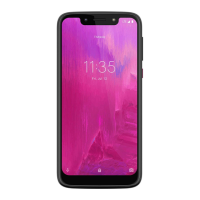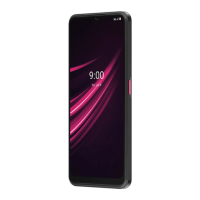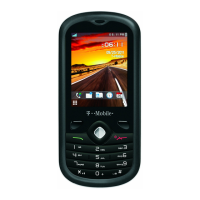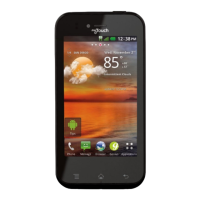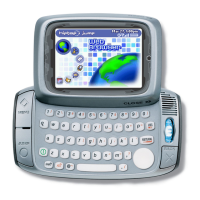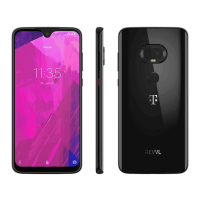

Do you have a question about the T-Mobile Revvlry+ and is the answer not in the manual?
| Brand | T-Mobile |
|---|---|
| Model | Revvlry+ |
| Category | Cell Phone |
| Language | English |
Identifies and labels the physical components and buttons of the phone.
Provides instructions on how to properly insert and remove SIM and SD cards.
Steps for adding or removing Google and other accounts to synchronize data.
Guide to setting up voicemail services, including password and greeting.
Instructions for configuring personal and corporate email accounts on the phone.
Personalizing the phone with wallpapers, ringtones, and security settings.
Adjusting screen colors and magnification gestures for visual impairment.
Features for users with hearing impairments, like video captions.
Controls for users with motor impairments, like external switch access.
Quick access methods for accessibility features via menus or volume keys.
Understanding and navigating the phone's primary interface and its elements.
How the lock screen functions and options for customization and security.
Guidance for first-time smartphone users transitioning to the Android operating system.
Benefits and management of your Google account for cloud storage and synchronization.
Explains the icons displayed in the status bar for monitoring phone status.
Definitions of common terms and concepts related to phone operation and features.
Explains basic touch, swipe, and pinch gestures for phone navigation and interaction.
How to use the on-screen navigation bar for moving between screens and apps.
Accessing and adjusting frequently used settings like Wi-Fi and Bluetooth quickly.
How to manage the phone's screen to save battery and secure the device.
Controlling different volume levels for calls, media, alarms, and notifications.
Instructions on how to activate and deactivate the phone's LED flashlight.
Methods for capturing images of the phone's screen content.
How to interact with the phone using voice commands for various tasks.
Using the phone's navigation features for turn-by-turn directions.
Tools and features to monitor and control daily phone usage and app time.
How to set background images for the home and lock screens.
Modifying the app shortcuts displayed in the bottom tray for quick access.
Adding widgets, app shortcuts, and organizing them into folders on the home screen.
Steps to remove unwanted widgets, shortcuts, or folders from the home screen.
Changing the phone's entire look and feel by installing and using new launcher apps.
Setting up animated images or photos to display when the phone is idle.
Options for securing your phone with PIN, pattern, password, or fingerprint.
Temporarily enhancing security by preventing lock screen notifications and auto-unlock.
Displaying a custom message on the lock screen for identification purposes.
Changing default call ringtones, contact-specific ringtones, and app notification sounds.
Silencing notifications, calls, and alerts to avoid disturbances.
Scheduling phone silencing based on specific days and times or calendar events.
Disabling audible alerts that occur when the phone is connected to a charger.
Instructions on how to launch and access applications installed on the phone.
Information about default apps and how to manage or disable them.
Downloading new applications from the Play Store or other sources and updating them.
Organizing, updating, and managing installed applications on your phone.
Utilizing split-screen view to run and interact with two applications simultaneously.
How to find, read, and respond to notifications from apps and the system.
Using Play Protect to scan for and remove potentially harmful applications.
Using the search widget and Google Assistant to find information online.
Locating files, apps, and contacts directly on your device using the search function.
Navigating and bookmarking web pages using the browser application.
How to compose, send, read, and manage SMS and MMS messages.
Saving photos, videos, or other files received via text messages.
Enabling or disabling group messaging features for conversations with multiple recipients.
Selecting a preferred app for sending and receiving text messages.
Customizing quick text responses to use when receiving incoming calls.
Managing your email accounts, reading, composing, and sending emails.
Attaching files, photos, or videos to outgoing email messages.
Removing individual or multiple emails from your inbox.
Downloading and saving files received as email attachments.
Creating and managing an automatic signature for your outgoing emails.
Adjusting settings to manage email notification alerts and sounds.
Introduction to the calendar app for tracking events and reminders.
Locating upcoming events and viewing them from notifications or the app.
Adding, editing, and managing calendar entries with suggestions and reminders.
Filtering which calendar events are displayed based on account or calendar selection.
Adjusting settings for receiving alerts and reminders about calendar events.
Creating, managing, and deleting alarms using touch or voice commands.
Utilizing countdown timers and a stopwatch for various timing needs.
Configuring automatic or manual date, time, and time zone settings.
Viewing and managing multiple time zones for coordinating with people in different locations.
Wirelessly sharing photos and videos via email, messages, cloud, or Bluetooth.
Automatically or manually backing up photos and videos to the cloud.
Accessing photos and videos that have been backed up to the cloud.
Using the phone to scan documents and save them as PDFs to Google Drive.
How to receive and manage incoming phone calls, including answering or declining.
Placing calls using the dialer, contacts, or voice commands.
Selecting a preferred application for making phone calls.
Adjusting settings like volume, speaker, mute, and using other apps during an active call.
Instructions for initiating video calls using apps like Duo.
Setting up and managing multi-person conference calls.
Preventing specific numbers from contacting you via calls or text messages.
Adding new contacts manually, from text messages, or automatically via accounts.
Modifying existing contact information or removing contacts.
Combining duplicate contact entries into a single listing.
Marking contacts as favorites for easier access in the Contacts and Phone apps.
Organizing contacts by first or last name and specifying name format.
Sharing contact information via name card files or text message attachments.
Listening to and managing voicemail messages through your carrier's system.
Routing all incoming calls from a specific contact directly to voicemail.
Tuning into FM radio stations using the FM Radio app and managing favorite stations.
Streaming or downloading music, playing various audio formats, and transferring music files.
Moving music files between devices using Bluetooth or USB connections.
Connecting the phone to a charger and tips for efficient charging.
Adjusting phone settings to conserve battery power and improve longevity.
Activating and configuring Battery Saver mode to extend battery life.
Overview of phone internal storage, SD card, and cloud storage for files.
Freeing up space by scanning for unused items and managing files.
Moving files to an SD card, ejecting it, and erasing its contents.
Locating and managing files downloaded from the internet or apps.
Attempting to restore deleted photos, videos, or texts using recovery apps.
Storing music library in the cloud for access on any device.
Using the phone to scan documents and save them as PDFs to Google Drive.
Searching for, connecting to, and managing Wi-Fi networks.
Turning off all wireless connections to comply with airline regulations.
Monitoring and managing cellular data usage, including setting data limits.
Controlling which apps can use data in the background to save data and battery.
Using the phone as a Wi-Fi hotspot or tethering via USB or Bluetooth.
Setting up a virtual private network connection for secure network access.
Pairing your phone with Bluetooth accessories and managing connections.
Utilizing connected Bluetooth devices for calls, music, and data sharing.
Connecting to compatible devices directly using Wi-Fi Direct without a router.
Setting up and using NFC for quick and secure contactless payments.
Sharing photos, videos, contacts, and files wirelessly using NFC or Android Beam.
Mirroring your phone's screen or playing media on a TV using Chromecast.
Moving files between your phone and computer using a USB cable.
Setting up and using Cloud Print to print documents wirelessly from your phone.
Managing default apps, permissions, and special app access for better control.
Controlling app notifications, sounds, and display behavior.
Using Ambient Display to view notifications when the screen is off.
Managing emergency alerts such as AMBER alerts and weather warnings.
Preventing the screen from rotating automatically or manually rotating apps.
Adjusting screen colors for a realistic or enhanced visual experience.
Managing screen brightness, including adaptive brightness settings.
Adjusting text size, icon size, and other display elements for comfort.
Customizing the background color of quick settings and app lists.
Setting the duration of inactivity before the phone's screen automatically sleeps.
Overview of phone security features, including screen locks and NFC.
Using Play Protect to scan and secure the phone against malicious applications.
Configuring screen lock options like PIN, pattern, password, or fingerprint for security.
Setting up trusted devices to keep the phone unlocked when connected.
Enabling and using face recognition for unlocking the phone.
Setting up trusted locations (like home or work) to automatically unlock the phone.
Using on-body detection to keep the phone unlocked when carried.
Setting up voice authentication using "OK, Google" for unlocking the phone.
Setting up and using the fingerprint sensor for unlocking and secure authentication.
Managing location settings and reviewing apps that access location data.
Setting up a SIM card lock to prevent unauthorized use of the cellular plan.
Adding and managing Google and non-Google accounts on the phone.
Managing how apps sync data with accounts and adjusting auto-sync options.
Reviewing, deleting, and controlling the information Google collects about you.
Adding emergency contacts and medical information for first responders.
Finding and recording the phone's unique IMEI number for identification and support.
Accessing electronic regulatory labels and model numbers for the phone.
Adjusting keyboard appearance, sounds, and typing features like glide typing.
Changing the phone's display language and adding keyboard languages.
Setting up user profiles, guest access, and screen pinning for sharing the device.
Managing user profiles, restricting calls/messages, and adding/removing users.
Creating and ending temporary guest profiles for sharing the phone.
Troubleshooting steps for performance issues like slowness or unresponsiveness.
Understanding why the phone may get warm and how to keep it cool.
Steps to fix issues where the phone fails to power on or shows a blank screen.
Troubleshooting random reboots, restarts, or shutdowns of the phone.
Steps to resolve a frozen or unresponsive phone screen.
Troubleshooting issues related to the phone not recognizing or reading the SD card.
Troubleshooting steps when the phone fails to recognize the SIM card.
Steps to resolve issues related to poor or no cellular network signal.
Troubleshooting when the phone has signal but cannot make outgoing calls.
Resolving issues with incoming calls not ringing or having low volume.
Addressing issues like the screen going black, dropped calls, or microphone problems during calls.
Troubleshooting when the microphone is not working or sound quality is poor during calls.
Troubleshooting steps for slow charging or when the phone does not charge.
Identifying reasons for rapid battery drain and steps to improve battery life.
Troubleshooting issues with pairing, connecting, and hearing audio via Bluetooth.
Resolving issues with connecting to Wi-Fi networks and maintaining stable connections.
Troubleshooting problems with connecting devices to the phone's Wi-Fi hotspot.
Steps to resolve issues when connecting the phone to a computer via USB for file transfer.
Steps to recover access if you forget your phone's unlock PIN, pattern, or password.
Troubleshooting issues preventing login to your Google account.
Resolving problems with data synchronization between accounts and the phone.
Troubleshooting missing apps/widgets, crashes, or apps not opening.
Steps to exit safe mode and regain access to disabled applications.
Troubleshooting issues encountered while using the Google Play Store.
Troubleshooting issues encountered while using the Gmail application.
Resolving issues with third-party apps, including updates and cache clearing.
Troubleshooting issues related to sending, receiving, or displaying text messages.
Resolving problems with the on-screen keyboard, such as missing keys or non-responsiveness.
Resolving issues with the camera app, such as blurry photos or errors.
Checking for and installing the latest Android software updates for optimal performance.
Resetting network settings to resolve connectivity issues with Wi-Fi, cellular, and Bluetooth.
Understanding the implications of resetting the phone and preparing for the process.
Finding assistance for billing, network issues, or learning to use apps.

